Welcome to the Chapel of St Kevin's
This is the heart of our school community
I lift up my eyes to the hills
From where, will my help come?
My help comes from the Lord who made heaven and earth.
Psalm 121:1-2
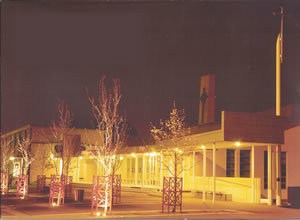
In keeping with the prayer of the Psalmist, the Architects Daryl Jackson Pty Ltd, were inspired to design a building that prompts us to raise our minds and hearts to the God ever present and central to our lives. The Chapel is named in honour of St Kevin, the founder of the monastery at Glendalough in Ireland. Some stones from the original Chapel of St Kevin in Glendalough are preserved in the wall of the chapel as a connection with the spirituality and learning that flourished in that Irish valley. Omnia Pro Deo.
The Chapel was blessed by Monsignor Gerald Cudmore AM and opened by Mr Des Powell, Chairman of the Board and Mr John McArdle, Chairman of the Appeal on the 5th of December 2001. The builders were Van Driel Pty Ltd.
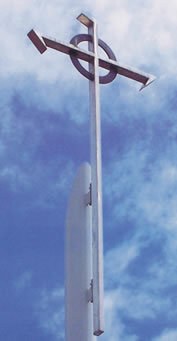
The Fle`che Cross
Designed by Orchard Studio
Donated to the College by the students of 2001.
The steel Fle`che Cross, stands high above the Chapel, a central sign of the significance of Christ’s transforming love for the entire College community. The Fle`che Cross contains the Celtic elements of the circle and the cross. It holds in balance the circle symbolizing the whole of God’s creation, held in tension by the cross of Christ’s transforming love. The arrow ends on the cross represent the lance that pierced the heart of Jesus. From this wound flowed the last remnants of Jesus’ life, given so totally in love for each of us.
Crucifix – Hand Carved Huon Pine River Red Gum, Stainless Steel
Designed by Orchard Studio Donated to the College by the Father’s Association
The figure of the broken Christ emerging in triumph from the confines of the Huon pine encourages us to contemplate the Crucifixion and Resurrection. The honey colour of the figure supported on the river red gum vertical beam, speak of the bread and wine of the Eucharist. In the celebration of Eucharist the bread is broken and shared out to the community as a means of remembering Jesus’ own act of self-giving. In the Chapel this is represented in the broken Jesus. When celebrating Eucharist the community gathers around the Altar. As the bread is broken at the table the community is invited to reflect on how they can break the bread of their own lives by bringing life to those in need. The image of the broken Christ stands above them creating a comforting yet challenging symmetry.
The stainless steel detail of the Crucifix is broken in five places, each rupture representing one of the wounds inflicted on the body of the crucified Jesus. This pattern is mirrored in the stainless steel detail of the water feature. These wounds while challenging, help to define the chapel’s space. It is within this space that the community finds its inspiration and hope.
Our Lady of Perpetual Help
This facsimile was done in Rome and modeled on the original which hangs above the High Altar in the Church of the Redemptorists in Via Nomentana, a short distance from the Basilica of Our Lady, Santa Maria Maggiore. It was placed in the porch of the first chapel on this site and when the new chapel was built was restored and refurbished and given its present place at the entrance.
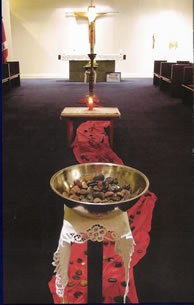
Pews, Central Space, and Lectern
The pews are arranged in choir formation to focus attention on the community that gathers around the Word and the Eucharistic Table. Together the pews, the altar and the lectern define a central space that remains open. It is into this space that the gathered community invites the presence of God into their lives. At the western end of this central space stands the altar, the table around which the community is inspired by the breaking of the bread and the drinking of the cup, symbols of God’s love for his people. At the eastern end is the lectern. It is from the lectern that the Word is proclaimed. It is in listening to this word that the community gains the inspiration to live out God’s covenant vision of a world characterised by freedom and peace. Many families who have been connected to the community have individually donated the pews to the College.
The Tabernacle
The tabernacle holds the consecrated Eucharistic bread. This tabernacle, which was donated to the College by Mr Leo O’Hearn, has been preserved from the original chapel. It carries the triangular symbol of the Trinity: God, Spirit and Jesus. Within this relationship we, the community, are drawn with the promise and hope of eternity, symbolized by the Greek letters Alpha and Omega. The tabernacle stands on a solid stone base. St Kevin’s College, throughout its history and into its future, will be a community committed to, and witnessing, this transforming vision of God’s love; a vision that will endure forever.
Sanctuary Lamp
Designed by Mr Anthony Russo of Orchard Studio The warm red glow of the lamp speaks of the hospitality of the gospel story. All are welcomed here. Just as the story of Jesus spoke of a universal love, so the sanctuary lamp speaks of the Eucharistic presence in the Chapel. A presence that is offered to all as a means of peace and comfort, always challenging and uplifting.
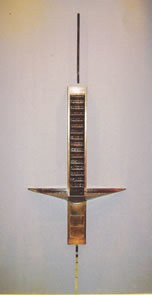
Chapel Water Feature/Font Cast Bronze, Stainless Steel
Designed by Mr Anthony Russo of Orchard Studio
Donated to the College by The Senior Mother’s Association
The Pilgrims entered the sacred valley of Glendalough, Ireland through the waters of the Lake of Healing. Here in the chapel of St Kevin you are invited to enter the space through the waters. The water reminds us of our baptism in faith and in our tradition symbolises healing and renewal. Spending time in this sacred space has the potential to bring renewal and healing to our lives.
The continuous flow of the water invites us to reflect on the everlasting nature of the Christian story and the constancy it offers the pilgrim searching for meaning and purpose in their lives.
Madonna and Child
Designed by Mr Mark Weichard of Orchard Design
In the concentrated gaze of the mother and the child is found the expression of a new hope dawning upon our world. In the Jesus story, it is Mary, the poor woman of Nazareth, who nurtured deep within her this promise of great hope for the world. As we contemplate the loving gaze between the Madonna and her child we are invited to reflect on the God that lives within us, and our call to nurture that spirit of God in our own lives.
St Kevin
Designed by Mr Mark Weichard of Orchard Design
St Kevin the mystic, who found the presence of God in the depths of the Glendalough valley, gently cradles a bird in his hands. The harmony that exists between Kevin and the bird speaks of the intrinsic connectedness we share with the earth and all living organisms. St Kevin the scholar, the man of prayer and lover of nature, calls us into a oneness with our world.
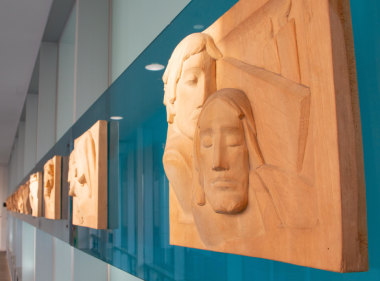
The Stations of the Cross
The hand carved stations purchased by the Christian Brothers community come from the original chapel of St Kevin built on this site and opened at a Mass celebrated by Father Ebsworth, Parish Priest of St Peter’s Toorak, Easter 1962. Their restoration in the Chapel of St Kevin was a gift to the College from the Past Mother’s Association. They depict the significant moments in Jesus’ passion. In praying The Stations of the Cross we connect with Jesus and his struggle through adversity. We are challenged to draw inspiration from Jesus and his inner strength. Just as he was transformed through the suffering of the cross so we are transformed by those daily struggles that call on us to be compassionate and to take a stand for justice and peace.
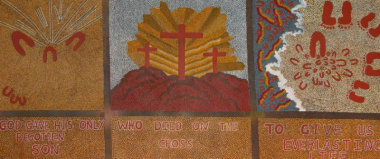
God gave his only begotten son
Audrey McCormack
Arrente people. Alice Springs NT
Synthetic polymer paint on linen
Audrey McCormack is a senior Arrente woman living in a town camp near Alice Springs. She is a member of the Tangentyere Council in Alice Springs and works as an artist, social researcher and environmentalist. She has been passionately engaged in anti-nuclear waste and social housing issues. As well as maintaining her traditional beliefs and stories she is a committed and practicing Christian. Audrey has not substituted Christianity for her traditional beliefs but has found a way to intergrate them as can be seen in this painting.
The title of this painting God gave his only begotten son is from St. John’s Gospel. The ‘U’ shapes on the left and right hand sides of this painting denote people sitting as this is the shape left by a body in the sand. The footprints on the right of the painting suggest people standing.
The painting is divided into three vertical sections similar to the traditional altarpiece format in European art. This arrangement is sometimes called a triptych which sometimes has a predella or horizontal section beneath it.
The imagery in the side panels is unclear but the panel on the left may represent Mary and Joseph each side of the baby Jesus with three wise men at the bottom left. The panel on the right may represent the resurrection or transfiguration of Jesus.
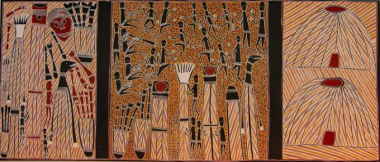
Ganalbingu Ceremony Story
Charlie Djurritini
b. 1952 Raminginging, Central Arnhem Land NT
2006, Ochre on canvas
Charlie Djurritini was born near a place called Matyka in the Arafura swamplands. As a child he went to the mission school at Milingimbi. He left school at about the age of 14 and worked as a labourer and mechanic’s assistant before becoming an artist.
The painting is the depiction of a Ganalbingu mortuary story. It tells a story about the funeral of an old man and a young girl.
The left panel of the painting depicts a ceremonial pole of a waterlily made with feathers that the leader of the ceremony would carry. There is also a hollow log coffin and a magpie goose totem. The bones of each person are in dilly bags before they are put into the log coffins.
The middle panel depicts the funeral ceremony with participants playing wooden music sticks (clap sticks) and didgeridu and dancing until the bones are ready to go into the hollow log coffins. Funeral ceremonies can sometimes last for weeks with dancing going on until everyone who was connected to the dead person feels that the spirit has come back into them.
The panel on the right represents two traditional paperbark shelters where participants would sleep and make a fire to keep the mosquitos away. They are made from young green trees covered with bark and have big holes at the top for the smoke to escape.
The work is painted with natural ochres dug from the ground and mixed with a binder, traditionally the sap of a wild orchid. The reddish brown colour is made by grinding the local sandstone to a fine powder and mixing it with orchid sap to make a paste. The black is either charcoal or manganese and the white is a sacred pipeclay that is often traded over hundreds of kilometres. Brushes are made with fine grasses or a well-chewed fibrous stick and sometimes with human hair.
The diagonal lines in-filled with cross-hatching in the painting are called ‘rarrk’. These lines are highly idiosyncratic and act as the artist’s personal clan signature.
In a 1998 interview Charlie said: ‘My father told me everything before he died. These paintings are for Balanda (white people) and Yolngu. These paintings are to show Balanda what my culture is. To show where my country and Dreaming is from. I only paint about one place, Mutyka – that’s my country. These pictures come from my head – I think about my culture’.
Charlie Djurritini is represented in the collections of:
National Gallery of Australia, Art Gallery of New South Wales, National Gallery of Victoria, Queensland Art Gallery, The Robert Holmes a Court Collection, Perth.
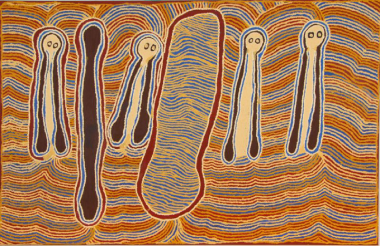
Land and Spirits
Linda Syddick Napaltjarri (Tjunkiya Wukula Napaltjarri)
c.1937 Lake MacKay, Gibson Desert WA
2005, Synthetic polymer paint on canvas
Linda Syddick lived a traditional, nomadic life until 1945 when, after many weeks travelling, her family walked out of the desert to the Christian mission at Haast’s Bluff. As a young woman Linda embraced Christianity which continues to influence her worldview and her painting.
The primary inspiration for her painting is the interconnectedness of Christian faith and Aboriginal mythology. Central to her work is the notion that spirits dwell in the sky, come to earth and interact with human beings, then return to their celestial home. These spirits, therefore, are not unlike the angels in European painting or the Gods in Greek mythology.
In Land and Spirits Linda has depicted her country in the sand painting style used for thousands of years to pass on Dreaming stories in Central Australia. For Linda these spirit figures inhabit the landscape and are just as real as Lake MacKay and the sand hills in her country. For her the land is filled with spirits, whether they be Christian spirits or ancestral spirits, and the land is holy. Her country near Maralinga was used to test Atomic bombs in the 1950’s.
On four occasions Linda has been a finalist in the Blake Prize, the national Australian award for religious art.
Linda Syddick Napaltjarri is represented in the collections of:
National Gallery of Australia, Art Gallery of South Australia, Museum and Art Gallery of the Northern Territory, Art Gallery of New South Wales, National Gallery of Victoria, Berndt Museum of Anthropology, Western Australia.